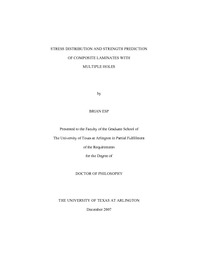
ATTENTION: The works hosted here are being migrated to a new repository that will consolidate resources, improve discoverability, and better show UTA's research impact on the global community. We will update authors as the migration progresses. Please see MavMatrix for more information.
Show simple item record
| dc.contributor.author | Esp, Brian | en_US |
| dc.date.accessioned | 2008-04-22T02:41:28Z | |
| dc.date.available | 2008-04-22T02:41:28Z | |
| dc.date.issued | 2008-04-22T02:41:28Z | |
| dc.date.submitted | December 2007 | en_US |
| dc.identifier.other | DISS-1969 | en_US |
| dc.identifier.uri | http://hdl.handle.net/10106/767 | |
| dc.description.abstract | The major purpose of this study was to investigate failure of composite laminates with multiple unloaded holes in close proximity. The least square boundary collocation method for anisotropic materials was utilized to determine the state of stress. The approach utilized collocation on both the internal and external boundaries, making it relatively easy to implement. The method compared favorably to both published and finite element solutions.
A failure prediction approach for an infinite, symmetric and balanced laminate, with two holes in close proximity was presented. The baseline material for consideration was IM7/977-3, a carbon fiber/epoxy lamina. The failure prediction method was an extension of the Whitney-Nuismer point stress failure criterion and was flexible enough to account for an arbitrary characteristic dimension value. Conditions for holes oriented transverse to the load and in-line with the load were considered. Both the "hole interaction effect" and "hole size effect" were simultaneously included in the failure prediction. Multiple hole spacings, hole size ratios, and layups were considered for stress distribution and strength prediction. For two equal holes oriented transverse to the load, the predicted strength was at least 95.0% of the single hole strength when the center to center distance divided by diameter, or l/D, was ≥ 3.5. For this same condition, the strength prediction response was nearly layup independent for l/D ≥ 3.0. The presented failure prediction approach was compared to published experimental data and was shown to have good correlation. A series of design curves were presented that allow for the quick determination of a structure's strength with two holes by only requiring the characteristic dimension for a single hole.
Two approaches to approximately determine the orthotropic stress concentration factor by using only two parameters were presented. Ten composite materials were investigated to determine the accuracy of the approximation for a variety of material systems. The results showed that a good approximation to the orthotropic stress concentration factor can be obtained by using only the parameters Ex/Ey and Ex/Gxy, regardless of the material system. | en_US |
| dc.description.sponsorship | Chan, Wen | en_US |
| dc.language.iso | EN | en_US |
| dc.publisher | Mechanical Engineering | en_US |
| dc.title | Stress Distribution And Strength Prediction Of Composite Laminates With Multiple Holes | en_US |
| dc.type | Ph.D. | en_US |
| dc.contributor.committeeChair | Chan, Wen | en_US |
| dc.degree.department | Mechanical Engineering | en_US |
| dc.degree.discipline | Mechanical Engineering | en_US |
| dc.degree.grantor | University of Texas at Arlington | en_US |
| dc.degree.level | doctoral | en_US |
| dc.degree.name | Ph.D. | en_US |
Files in this item
- Name:
- umi-uta-1969.pdf
- Size:
- 2.849Mb
- Format:
- PDF
This item appears in the following Collection(s)
Show simple item record


